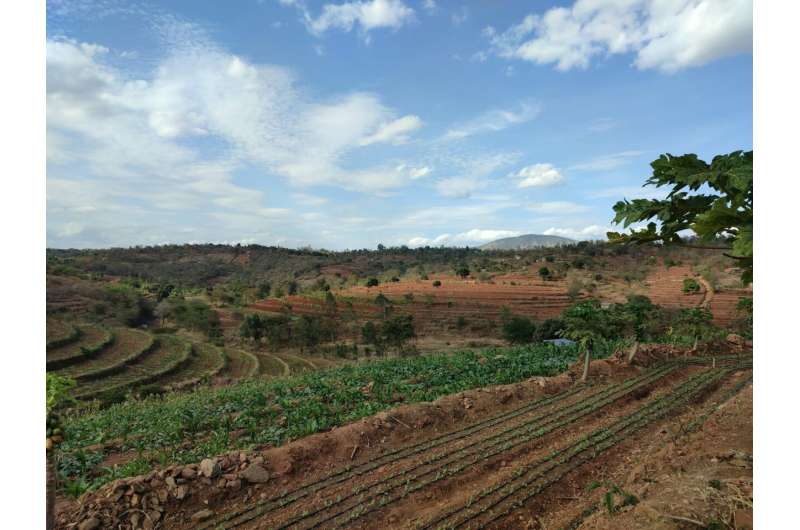This article has been reviewed according to Science X's editorial process and policies. Editors have highlighted the following attributes while ensuring the content's credibility:
fact-checked
peer-reviewed publication
trusted source
proofread
Balancing the potential and pitfalls of solar-powered groundwater irrigation

In a bid to meet growing food production and energy needs in low- and middle-income countries, solar-powered groundwater irrigation is rapidly gaining ground. More than 500,000 solar pumps have been installed in south Asia over the last few years and a major expansion is planned across sub-Saharan Africa.
While the technology presents important opportunities to mitigate greenhouse gas emissions, an article, titled "Risks from solar-powered groundwater," published in Science suggests that anticipated emissions reductions are complex to calculate and solar pumps are likely to increase groundwater depletion as farmers gain access to cheap, clean energy.
Dustin Garrick, professor in the School of Environment, Resources and Sustainability, co-led the Science article with Dr. Soumya Balasubramanya of the World Bank. Along with an international team, they examined the trend toward solar pumps as a clear opportunity for boosting agricultural yields and alleviating poverty, but the opportunity comes with risks.
"Solar-powered groundwater irrigation is booming and represents a promising technology for alleviating poverty by expanding access to irrigation for poor farmers, but this potential comes with risks of depleting groundwater and drying up wells over the longer term. It is crucial for communities and governments to invest in measuring and managing these risks," Garrick says.
In sub-Saharan Africa, governments are enabling the growth of small farms by reducing import and other taxes on solar pumps, while encouraging private vendors to sell and install them. In Bangladesh and Nepal, more than 2,000 units have been installed while India intends to exceed this number—installing 2 million small stand-alone pumps and solarizing 1.5 million existing electric pumps by 2026.
"Ensuring that the benefits of solar irrigation reach farmers who rent their land, or those whose landholdings are too small for pump ownership, is critical for enhancing the poverty alleviation potential of this technology," Balasubramanya notes.
"Insights from emerging collaborations between government agencies, entrepreneurial initiatives and pump manufacturers in south Asia and Africa could improve policy responses and scale services to vulnerable farmers."
While replacing electric or diesel pumps with solar-powered irrigation holds the promise of reducing carbon emissions, it is not guaranteed. Farmers who have access to these pumps may expand production of crops or diversify into other activities, which are not emissions neutral.
Solar pumps will increase groundwater abstraction, which may be desirable in aquifers that support such increases, but this could exacerbate groundwater depletion in aquifers that are already stressed. The cheap clean energy of solar pumps may lead to increased groundwater development, without necessarily decreasing overall emissions.
Despite these challenges, the clean-energy boom can serve as a catalyst for positive change in water and energy management but will require enhanced regulation and planning in both low- and high-income settings.
Garrick and Balasubramanya advocate for improved data collection initiatives, with a shift from siloed to integrated approaches. They suggest leveraging technology to measure water abstraction and collecting remotely sensed data to monitor land use changes. As well, regulatory improvements are crucial, with cumulative limits for carbon emissions and groundwater depletion established at various levels.
With groundwater management already a difficult challenge, we must act swiftly to understand the implications of the clean energy boom and poverty alleviation initiatives to avoid these gains being eroded by wells running dry.
The rapid adoption of solar irrigation intensifies the urgency, demanding adaptation from governments and institutions. Increased regulatory efforts to establish cumulative limits for carbon emissions and groundwater depletion become paramount to navigate these complexities.
Investing in monitoring networks and targeted subsidies holds the key to encouraging both consumers and producers to adapt their behavior for the better. As we embrace advances in data, entrepreneurs and policymakers are empowered to set realistic expectations, ensuring equitable and sustainable benefits, and effectively managing risks amidst the continued expansion of solar irrigation.
An open-access version of the manuscript and blog on the paper are available on the World Bank's website.
More information: Soumya Balasubramanya et al, Risks from solar-powered groundwater irrigation, Science (2024). DOI: 10.1126/science.adi9497


















